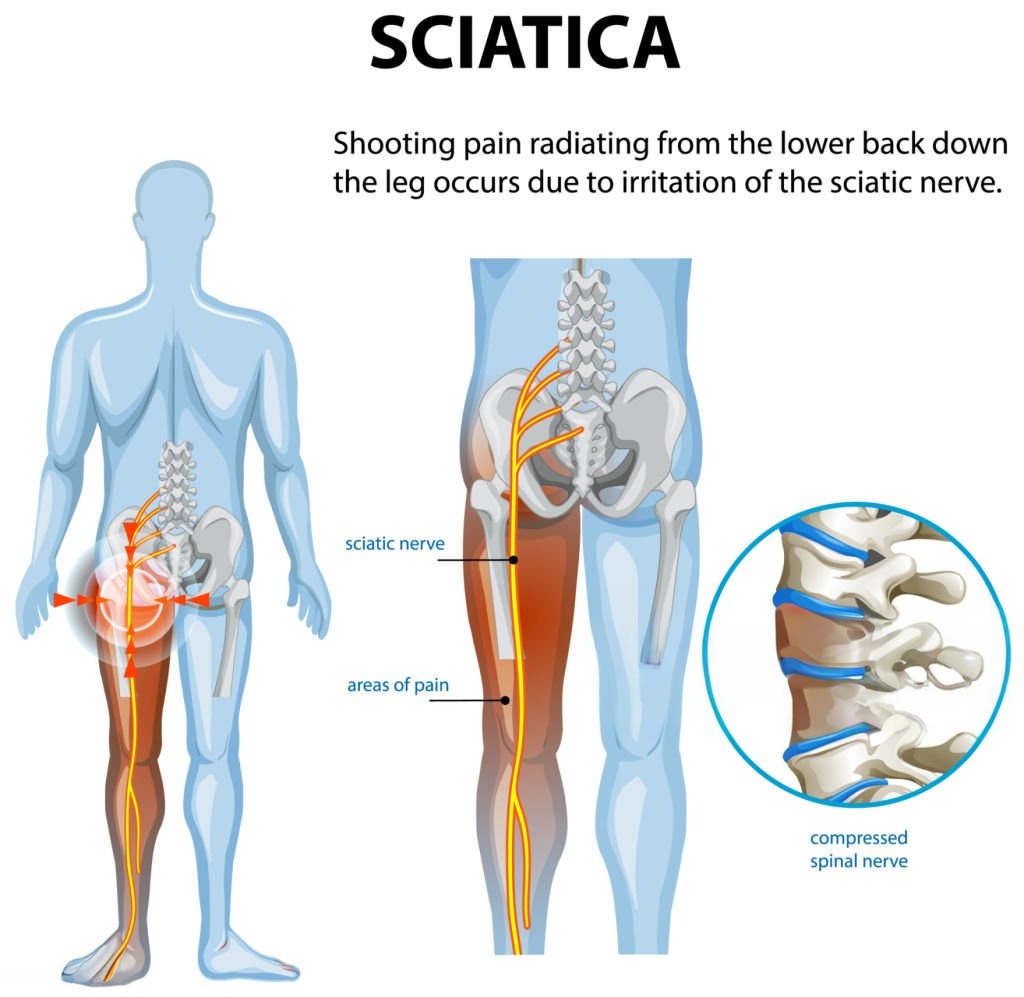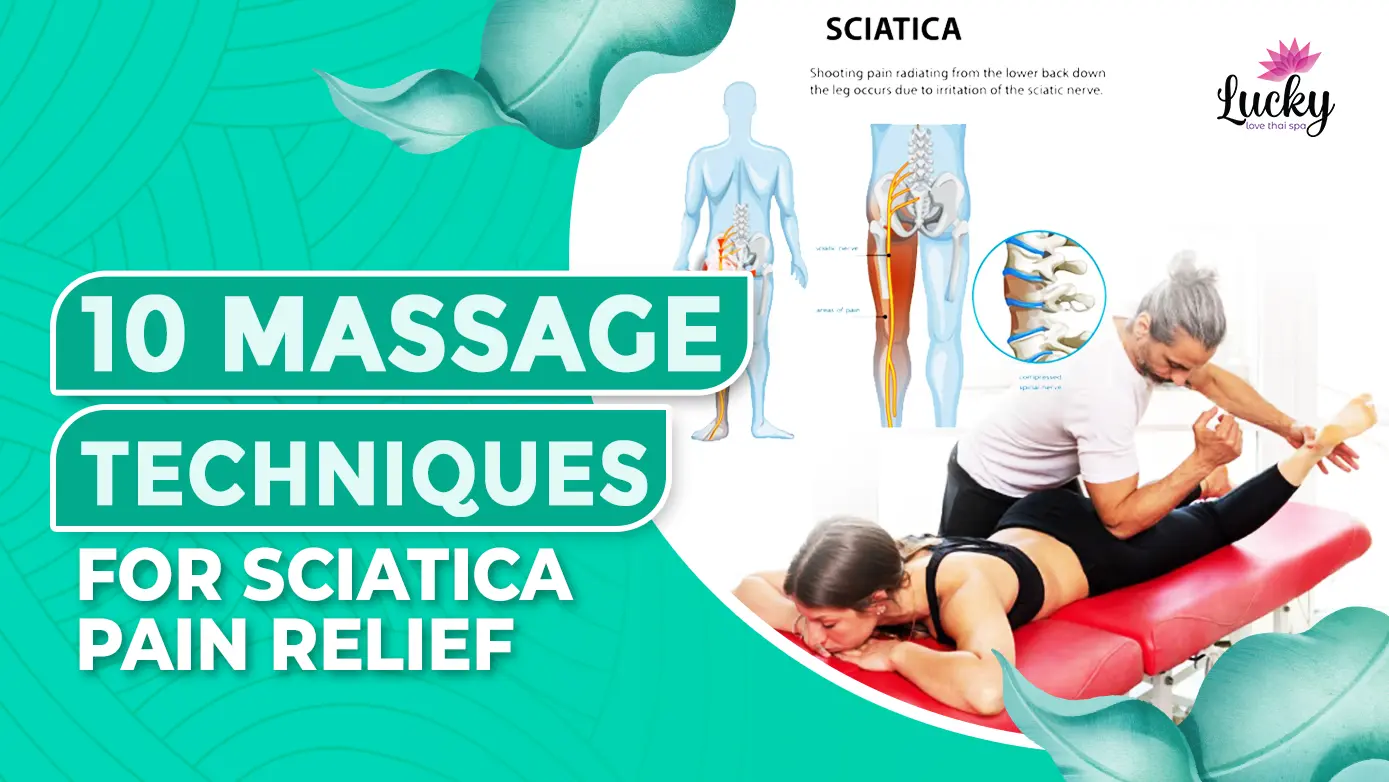Sciatica isn’t just an ordinary backache. It can make simple tasks like sitting, walking, or climbing stairs feel uncomfortable. While stretches, medications, and physical therapy help, massage therapy offers a natural, effective way to ease tension, improve blood flow, and relieve nerve pressure.

In this guide, we’ll walk you through 10 massage techniques for sciatica pain relief, including tips for professional application, safe self-massage at home, and what sensations you may feel.
With these sciatica pain massage techniques, you can move more freely, reduce discomfort, and give your sciatic nerve the care it needs.
What is Sciatica Pain?
Sciatica describes pain that travels along the path of the sciatic nerve—the longest nerve in your body. It starts in the lower spine, winds through the hips and buttocks, and runs down each leg. Sciatica itself isn’t a disease; it’s a symptom caused by nerve compression, irritation, or inflammation.
Typical Symptoms of Sciatica You May Notice:
- Intense, shooting pain in the lower back, buttocks, and leg
- Tingling, burning, or numbness along the nerve’s path
- Weakness or reduced reflexes in the affected leg or foot
- Pain that worsens when sitting or standing still for long periods
Can Massage Help with Sciatica Pain Relief?
Yes, massage therapy can be an effective complement to stretching, posture correction, and medical treatment for sciatica. Unlike medication, which only masks pain temporarily, massage addresses muscle tension and tissue restrictions that may compress the sciatic nerve.

Here is how massage relieves sciatica pain:
- Relax tight muscles in the lower back, hips, glutes, and hamstrings that may be pressing on the nerve.
- Enhance blood flow, which brings oxygen and nutrients to promote healing.
- Reduce inflammation around the sciatic nerve and surrounding tissues.
- Stimulate sensory nerves to override pain signals temporarily.
- Loosen fascia and connective tissue to enhance mobility and reduce discomfort.
10 Best Massage Techniques for Sciatica Pain Relief
Having sciatica can make even the simplest movements a challenge. You can use these 10 massage techniques for sciatica back pain relief at home or visit a professional spa center in Gulshan, Dhaka.
Below is a quick overview of each massage technique, so you will know what to expect and who it will benefit the most.
| Sl No | Massage Technique | Primary Focus | Best For |
| 1 | Deep Tissue Massage | Deep muscle layers and connective tissue | Chronic tension, severe pain |
| 2 | Trigger Point Therapy | Muscle “knots” refer to pain in the leg | Piriformis-related sciatica |
| 3 | Myofascial Release | Loosens fascia and improves flexibility | Stiffness, restricted movement |
| 4 | Neuromuscular Massage | Balances muscle tone and nerve function | Persistent muscle imbalances |
| 5 | Swedish Massage | Circulation and relaxation | Mild to moderate pain, stress relief |
| 6 | Sports Massage | Deep work combined with stretching | Active individuals, recurring strain |
| 7 | Hot Stone Massage | Uses heat to relax tight muscles | Chronic tightness, poor circulation |
| 8 | Gluteal Muscle Massage | Focuses on the gluteus maximus, medius, and minimus | Hip mobility, deep buttock pain |
| 9 | Piriformis Stretch & Massage | Releases the piriformis muscle pressing on the nerve | Piriformis syndrome, hip stiffness |
| 10 | Sacrum Pressure Release | Relieves tension at the base of the spine | Pelvic alignment, lower back relief |
Now let’s explore each massage therapy for sciatic nerve pain in detail, along with what you might feel during the massage and how you can safely try self-massage at home.
1. Deep Tissue Massage
Deep tissue massage for sciatica pain targets the deeper layers of muscles and connective tissues that often cause sciatic pain. It’s especially effective for tight glutes, hamstrings, and lower back muscles, compressing the sciatic nerve.
What You Might Feel: Firm pressure at first, followed by a warm, releasing sensation as tension melts away. Some areas may feel tender, which is normal.
Professional Approach: Massage therapists use fingers, knuckles, or elbows to apply steady pressure to the lower back, hips, and hamstrings. Each spot is held for 30–60 seconds, gradually adjusting as muscles relax.
Self-Massage Tip: You can sit on a foam roller or place a massage ball under your glutes or hamstrings. Slowly roll to identify tense areas, pausing for 20–30 seconds. Adjust your weight to increase or decrease pressure. Focus on feeling muscles release rather than forcing them.
2. Trigger Point Therapy
Trigger point therapy for sciatica pain addresses “knots” in muscles that radiate pain down your leg. These points are often in the piriformis or gluteus minimus, which can irritate the sciatic nerve.

What You Might Feel: Initial discomfort or intensity while applying pressure, followed by gradual relief and less radiating pain.
Professional Approach: Therapists locate knots in the glutes or hips and maintain firm pressure for 30–60 seconds. Repeat for all tight spots while avoiding direct nerve contact.
Self-Massage Tip: Stand against a wall and press a tennis ball into the glute or hip. Lean gently and hold each area for 20–30 seconds. Move slowly to the next spot. You should feel tension easing rather than sharp pain.
3. Myofascial Release
This technique targets the connective tissue (fascia) surrounding muscles. Tight fascia can compress nerves, restrict movement, and worsen sciatica.
What You Might Feel: Gentle stretching, softening, and sometimes a tingling warmth as fascia loosens.
Professional Approach: The therapist uses slow, broad pressure for two to five minutes on the lower back, glutes, and hamstrings, allowing each area to release.
Self-Massage Tip: Sit on a foam roller, crossing one ankle over the opposite knee. Slowly roll your glutes and lower back, pausing on tight spots for 20–30 seconds. Repeat while controlling pressure with body weight.
4. Neuromuscular Massage
Neuromuscular massage for chronic sciatica blends deep tissue and trigger point techniques to balance muscle tone and reduce nerve irritation. It is ideal for chronic sciatica or persistent muscle imbalances.
What You Might Feel: Firm pressure combined with gentle stretching. Muscles often “unwind,” improving hip and lower back mobility.
Professional Approach: An experienced massage therapist applies slow, precise pressure, along with gentle stretches, to enhance circulation and relaxation.
Self-Massage Tip: Use a foam roller or massage ball along the glutes and hamstrings. Press gently into tight spots, rolling slowly for 20–30 seconds.
5. Swedish Massage
Swedish massage techniques for sciatica pain relief use long, flowing strokes and rhythmic kneading to enhance circulation, relax muscles, and relieve stress.

What You Might Feel: Gentle warmth and loosening in the lower back, glutes, and hamstrings. It also brings a calming effect, reducing pain perception.
Professional Approach: Therapists perform long strokes along the back and legs, gently kneading tight areas to improve comfort.
Self-Massage Tip: Use your palms to stroke the lower back and glutes in smooth, rhythmic motions. Breathe deeply to enhance relaxation, and focus on areas that feel tight or stiff.
6. Sports Massage
Sports massage for sciatic nerve strain combines deep tissue work with stretching to release tight muscles and improve flexibility. It’s especially useful for sciatica caused by overuse, muscle strain, or sports injuries.
What You Might Feel: Firm, targeted pressure on specific muscles, followed by stretches that may feel intense but relieving. A light soreness afterward is normal as muscles adjust.
Professional Approach: Therapists use deep strokes, friction, and assisted stretching for the lower back, glutes, and hamstrings. They often focus on muscle groups overworked from running, lifting, or repetitive movements.
Self-Massage Tip: Use a foam roller on your hamstrings and glutes after light activity. Roll slowly for 30–60 seconds per area, pausing where you feel tightness. Finish with gentle hamstring and hip stretches.
7. Hot Stone Massage
Hot stone massage uses smooth, heated stones to relax muscles before deeper work begins. The heat boosts circulation and allows tight tissues to release more easily.
What You Might Feel: A soothing warmth that melts away tension. The heat penetrates deep, making it easier for muscles to loosen.
Professional Approach: Therapists place heated stones along the spine, hips, and legs, then use them to massage in slow, flowing strokes. Heat is adjusted to the comfort level.
Self-Massage Tip: At home, you can use a warm compress or heating pad on the lower back and glutes for 10–15 minutes before stretching. Avoid extreme heat to prevent burns.
8. Gluteal Muscle Massage
The gluteus maximus, medius, and minimus play a major role in hip movement. Tightness here can directly irritate the sciatic nerve.
What You Might Feel: Deep pressure in the buttock muscles, often with referred sensations down the leg. Relief follows as tension releases.
Professional Approach: Therapists use knuckles, elbows, or forearms to work into the glutes. Sometimes, combining with stretches for the hips and lower back.
Self-Massage Tip: Sit on a tennis ball or massage ball under one buttock, shifting slightly to find tight spots. Hold each area for 20–30 seconds, breathing slowly to encourage release.
9. Piriformis Stretch & Massage
The piriformis is a small, deep hip muscle that can irritate the sciatic nerve when tight. Using this technique, you will release the piriformis muscle and improve the rotation of your hips, easing leg pain.
What You Might Feel: Pressure deep in the hip with possible radiating sensations down the leg. Stretching should feel relieving, not sharp.
Professional Approach: Therapists use deep, precise pressure on the piriformis, followed by guided stretches to lengthen the muscle and ease nerve pressure.
Self-Massage Tip: Lie on your back, cross one ankle over the opposite knee, and gently pull the lower leg toward your chest. Hold for 20–30 seconds, then switch sides.
10. Sacrum Pressure Release
By releasing the sacrum pressure, tension in the surrounding gluteal muscles is reduced, and pelvic alignment is supported. It is particularly helpful if sciatica is caused by prolonged sitting or misalignment.
What You Might Feel: A slow, soothing pressure that encourages muscles around the sacrum and lower back to relax. Over time, you may notice improved posture and less strain on the sciatic nerve.
Professional Approach: The therapist applies gentle, sustained pressure to the sacrum and surrounding muscles. It involves slow, deliberate movements, repeated several times to encourage deep relaxation without compressing nerves.
Self-Massage Tip: Stand or sit with a fist placed on your sacrum. Hold each area for 20–30 seconds, using your other hand to stretch the glutes around it.
When to Seek Professional Help for Sciatica Pain Relief

While these massage techniques for sciatica pain can be highly effective, you should consult a doctor or physiotherapist if you experience:
- Pain that starts suddenly, is severe, or follows trauma such as a fall or accident.
- Persistent numbness, tingling, or noticeable weakness in the leg or foot.
- Changes in bowel or bladder control may indicate a rare but serious condition called “cauda equina” syndrome.
- Sciatica pain that does not improve despite consistent massage, stretching, or other therapies for 4–6 weeks.
With expert care, you are sure to address the underlying cause of sciatica safely while still receiving targeted massage techniques to reduce muscle tension and support recovery.
To Wrap Up
Sciatica doesn’t have to control your day. By combining these 10 massage techniques for sciatica pain, you can reduce muscle tension, ease nerve pressure, and improve circulation. Paired with proper posture, stretches, and occasional professional guidance, these methods make daily movements more comfortable and help you regain freedom of motion.
Try them safely at home or with a massage therapist to experience noticeable relief and better mobility.
Frequently Asked Questions
Are there any contraindications to massage techniques for sciatica pain?
Yes. Conditions like acute inflammation, fractures, deep vein thrombosis, or severe nerve pain require avoiding deep pressure. Always share your medical history with a qualified therapist so they can adapt techniques, opting for gentle, circulation-friendly methods.
How often should you schedule a massage to feel real sciatica pain relief?
For noticeable relief, aim for 1–2 massage sessions weekly over several weeks. Combine with stretches, gentle movement, or heat therapy at home to enhance results.
Are there self-massage options for sciatica pain at home?
Absolutely! Gently rolling a tennis or massage ball along your glutes and piriformis, paired with light nerve stretches, can provide noticeable relief right from home.

